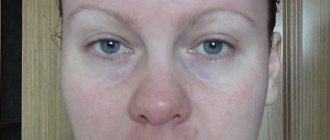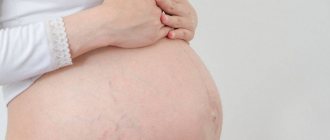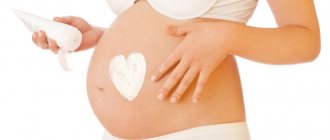What your facial skin tells you during pregnancy
Often, you can guess that a woman is expecting a baby even before the characteristic roundness appears in the abdominal area. Just look at it: very often the skin of the face changes noticeably in the early stages of pregnancy. This is due to hormonal changes occurring in the body. Such changes do not always please the expectant mother, but it is important to understand that they are completely natural.
FACE COLOR AND PIGMENTATION
The first thing you can notice is changes in facial skin tone during pregnancy. Often the expectant mother’s cheeks are too brightly colored. This indicates an increased load on the blood vessels, which is quite natural during pregnancy. If a woman already had freckles, they may become even more noticeable. Brown-haired and brunette women often encounter chloasma, popularly known as the mask of pregnant women. In this case, individual areas on the forehead, cheeks, chin, as well as on the back of the nose and under the lip darken. Because of this, the skin of the face acquires an uneven shade. Skin pigmentation in expectant mothers is completely natural: this is a consequence of increased levels of progesterone in the body. But don’t think that such changes will remain forever. Even if the skin of the face deteriorates during pregnancy, as a rule, after the birth of the baby, it gradually returns to its previous shade. So it is not necessary to resort to complex procedures to combat pigmentation, just be patient.
SWELLING
Many women expecting a baby experience swelling. They are especially noticeable on the face. Due to swelling, it becomes larger and rounder. Such changes can be expressed to varying degrees. How to determine whether swelling has appeared? To do this, gently press on the skin with your finger. If a hole has formed on it, most likely, we are talking about the presence of edema. In this case, it is important to consult with your pregnancy doctor in a timely manner. The specialist will adjust the diet and also prescribe treatment, if necessary.
EXCESSIVE HAIR
At the end of the first trimester of pregnancy, many women notice that the amount of hair on their body has increased. Noticeable hairs may also appear on the face. This is due to the increase in the level of androgens, sex hormones, that occurs during this period. To remove facial hair, you can use tweezers, sugar or wax hair removal. However, during pregnancy it is not recommended to use chemicals to combat unwanted vegetation. In fact, it is not at all necessary to remove hairs that have grown on your face and body: they will disappear on their own about six months after giving birth.
RASHES
Many women complain that their perfectly clean skin has deteriorated during pregnancy: pimples have appeared on it. Rashes can be associated with both an allergic reaction and hormonal disorders. When it comes to allergies, a small, clearly visible rash usually appears on the skin, which may be accompanied by itching. With hormonal changes associated with an increase in progesterone levels, the work of the sebaceous glands is activated. As a result, acne may appear on a pregnant woman's face. The occurrence of such problems is facilitated by an unbalanced diet, genetic factors, and lack of fresh air. If acne appears, you should consult a dermatologist, making sure to inform the specialist about your ongoing pregnancy. The doctor will select therapy taking into account the woman’s condition: not all components of medicinal creams, lotions and other products are approved for use during this period.
DOES THE CONDITION OF THE SKIN ALWAYS CHANGE FOR THE WORSE?
You should not think that carrying a baby will certainly lead to a deterioration in the appearance of the expectant mother. It often happens that the skin of the face during pregnancy glows with health and beauty! Hormonal changes can improve cell function and have a rejuvenating effect on the body. In addition, the expectant mother has the power to properly care for her skin to help maintain its elasticity, softness and healthy tone.
HOW TO PROPERLY CARE FOR YOUR SKIN DURING PREGNANCY
Use suitable cosmetics. During this period, it is especially important to study the composition of cosmetics. To cleanse the skin, it is recommended to use mild products without aggressive components. If rashes appear, the best option is doctor-recommended products with antiseptic ingredients. You can use cosmetics designed specifically for pregnant women.
Protect your skin from the sun. At any time of the year, it is important to apply cream with SPF factor before going outside. Exposure to ultraviolet light can increase pigmentation, which appears under the influence of hormonal changes.
Choose gentle procedures. Deep peelings and traumatic mechanical facial cleansing are not suitable for pregnant women, because during this period the skin becomes especially sensitive and the pain threshold decreases.
Watch your diet. It is recommended to include foods rich in polyunsaturated fatty acids, fiber, and vitamins in the menu.
Lead a healthy lifestyle. Regular walks in the fresh air, good sleep, moderate physical activity - all this is beneficial not only for the skin, but also for the health of the pregnant child.
Allergies during pregnancy: the effect of allergies on the fetus
25.05.2021
Epidemiological data show that 15-30% of women of childbearing age suffer from allergic diseases. Allergies often worsen during pregnancy and can complicate pregnancy.
Allergies during pregnancy
Allergies can be a group of disease symptoms caused by contact with environmental factors that do not cause allergic reactions . Exposure to external factors, called allergens , activates the immune mechanisms of the allergic person. After this, the immune system begins to stimulate the body's cells to release various substances that cause inflammation.
Allergens can be divided into:
- inhaled;
- food;
- contact.
Depending on which allergen is the source of sensitization, different symptoms will appear. Inhaled allergens mainly cause respiratory diseases, and contact allergens cause skin reactions.
Allergies may worsen during pregnancy . This mainly applies to allergic rhinitis and asthma . Moreover, some allergic diseases appear for the first time during pregnancy . One of them is atopic dermatitis , which is the most common dermatosis among pregnant women.
The effect of allergies on the fetus
Allergies can negatively affect fetal development.
The following allergic diseases can affect the course and outcome of pregnancy:
- asthma;
- allergic rhinitis;
- conjunctivitis;
- hives;
- anaphylaxis;
- food allergy;
- drug allergy .
Women with asthma are primarily at increased risk of complications during pregnancy and childbirth . Experts estimate that up to 10% of pregnant women suffer from asthma . Research into asthma during pregnancy suggests it can slow down a baby's development. It can also lead to premature birth and low birth weight of the fetus. Because of the above complications, pharmacotherapy during pregnancy will be much less of a threat to the fetus than untreated asthma .
Allergy medications during pregnancy
During pregnancy , many changes occur in a woman's body. They concern almost all systems, especially the cardiovascular, respiratory, urinary, digestive and endocrine systems. The body of a pregnant woman is preparing to create appropriate conditions for the development of the fetus.
Due to changes in the functions of many organs and direct effects on the fetus, a pregnant woman needs to be especially careful when taking medications. Moreover, the annotations of most medications indicate that they are contraindicated in pregnant women.
Most allergic diseases are treated with antihistamines, which block the physiological effects of histamine. Histamine is the main mediator of allergic reactions . Antihistamines that are safe for pregnant women include: cetirizine, loratadine, clemastine, cyproheptadine and diphenhydramine.
Pregnant women should absolutely not take:
- antazolines;
- fexofenadine;
- hydroxyzine;
- promethazine;
- ketotifen;
- Levoceterizine.
Women with asthma may take bronchodilators and anti-inflammatory drugs during pregnancy Safe drugs include sympathomimetics - mainly salbutamol, fenoterol, formoterol, terbutaline and inhaled glucocorticosteroids: budesonide and beclomethasone. Oral corticosteroids are not recommended during pregnancy .
In the case of allergic rhinitis , in addition to antihistamines, pregnant women can use nasal corticosteroids, mainly budesonide, and, if necessary, beclomethasone and fluticasone, since there are still no studies confirming their harm during pregnancy .
For atopic dermatitis during pregnancy , topical emollients and antipruritic drugs are recommended. If their use does not bring improvement, general therapy with antihistamines is prescribed.
Home remedies for allergies during pregnancy
In addition to pharmacological agents, pregnant women with allergic rhinitis can use inhalations with sea water or 0.9% saline solution. There are many herbs that help relieve skin and intestinal allergy , but a pregnant woman should consult her doctor .
Published in Allergology Premium Clinic
Complexion and female beauty
As already noted, a change in the complexion of a pregnant woman is also possible. It’s rare, but you can hear the phrase “mask for pregnant women.” When pigment spots of different saturation appear on the face, in particular on the forehead or on the cheeks. Their saturation depends on the color of the pregnant woman’s skin: the darker the skin, the brighter the pigment spot. In bright blondes with pale snow-white skin, the spots may be light brown, beige, and sometimes slightly pinkish. At times, some expectant mothers note that they have become much “more shy” than before. This refers to the fact that rosy cheeks appear much easier and faster than before. A light blush covers not only the cheeks, but also the ears and eyelids of a pregnant woman. These symptoms go away after childbirth, and the ability for causeless redness of the cheeks also goes away.
Pigment changes can occur throughout the body. Estrogens and progesterones produced in much larger quantities cause existing age spots and moles to darken. And sometimes they contribute to the appearance of new spots and spots on any part of a woman’s body. It is better to protect yourself from ultraviolet radiation by wearing beautiful and stylish hats, beanies, caps, baseball caps, elegantly tied scarves and kerchiefs. Everything that is fashionable in the coming seasons.
It is not the best option to try to somehow influence these changes through modern cosmetic procedures such as peeling or banal whitening. We should not forget that during pregnancy, especially at the end of the second trimester, a woman’s skin is especially sensitive, and no one knows how she will behave after such procedures. Especially in hot weather, and even with increased sweating, small wounds heal poorly, and it is very easy for any infection to join them. If the skin, on the contrary, has become drier, then the wounds will leave a deep mark, like after smallpox.
Rejoice in your pregnancy, and everything else will pass with the onset of labor.
When and which doctor to contact
Usually a doctor is consulted:
- if the rash spreads over a large area;
- when symptoms increase;
- when signs of general intoxication occur;
- if the urticaria does not go away on its own after eliminating the factor that caused it;
- if the disease becomes chronic or often recurs,
It is advisable not to delay your visit to the doctor and come when the first manifestations of the disease occur. Then it will be easier to establish the cause, and treatment will take less time. In addition, the doctor will recommend what to do to prevent hives.
A therapist or pediatrician, a dermatologist can provide assistance with urticaria, and an allergist is involved in targeted diagnosis and treatment.
Methods for treating wisdom teeth during pregnancy
If the wisdom tooth has not fully erupted, and the gums in this place have formed a kind of “hood,” then food debris can accumulate there and cause the proliferation of pathogenic bacteria. In this case, you will have to cut into the gum, remove part of its tissue, open the tooth and give it the opportunity to grow further. When a visual examination does not accurately determine the extent of the problem, the doctor prescribes an x-ray examination, which establishes the position of the tooth, what condition it is in and whether it will grow correctly. You should not be afraid of this type of diagnosis during pregnancy. Since modern low-dose X-ray machines used in dentistry produce a radiation dose that is several times less than the hot sun in the summer.
If the x-ray has shown that the position of the tooth inside the gum does not cause concern, you can ease the painful eruption of the “eight” with simple procedures: baths and rinses with warm solutions of salt and soda, decoctions of chamomile or calendula, etc.
Is it possible to remove a problematic tooth while pregnant?
Dental treatment during pregnancy is recommended from the 3rd to the 6th month. If necessary, to get rid of problems with wisdom teeth, painkillers that are completely safe for pregnant women are used. Since an unerupted, traumatic, inflamed “figure eight” as a source of infection is much more dangerous to health than local anesthesia. As for the removal of wisdom teeth during pregnancy, there must be strong indications for this procedure. Since during the period of bearing a child, manipulations related to getting rid of a tooth are undesirable.
If the dental problem persists, then it is better to wait to resolve it until the postpartum period. However, if x-rays and symptoms show that tooth extraction is necessary and this is possible with the least discomfort, then it is better to get rid of the problematic “eight”. Under what circumstances is wisdom tooth removal recommended?
- “The figure eight” systematically injures the surrounding tissues (tongue, cheek), as it is knocked out of the dentition.
- Frequent inflammation of the gums above the wisdom tooth, re-formation of the “hood” after removal.
- Unbearable pain and the presence of a dental cyst.
- There is no way to reach the tooth and provide proper treatment to rid the oral cavity of a constant source of infection.
- A wisdom tooth does not carry a noticeable functional load, and if it is expensive and difficult to treat, then it makes sense to simply remove it.
When the figure eight is in a lying position, it is recommended to get rid of it. But if it doesn’t bother you yet, then it’s better to wait until the baby is born and do tooth extraction in the postpartum period. Modern anesthetics used to get rid of a diseased tooth are safe both during pregnancy and while breastfeeding a child.
What kind of inconvenience can a wisdom tooth cause?
A characteristic feature of the so-called “eights” is that they may “want” to erupt in adulthood. At the same time, wisdom teeth do not have milk predecessors, which, as it were, prepare the way for the growth of more mature teeth. In addition, the “eight” may be in a pathological lying position. All this provokes discomfort, causes pain and inflammation of the gums when the tooth is cut inappropriately. And the wisdom tooth itself may eventually become damaged, requiring long-term treatment or even removal.
Therefore, wisdom teeth during pregnancy need special attention, as they can become a source of infection for the female body, which already has a difficult time during pregnancy.
Possible external changes in the vascular system
Blood circulation increases, and naturally the bone marrow tries to produce blood cells in a much larger volume, and the heart organ moves slightly due to the growing uterus and increases in size. All these changes contribute to changes in skin color in different parts of the body. A striking example is the darkening of the areola. Similar changes also appear on some parts of the face, and a pigment line may also appear, running from the navel to the pubic bone. Exposure to sunlight can aggravate the situation, so in the summer you should cover the most exposed areas from direct exposure to the sun or use a protective cream.
In addition, since the load on the vessels, including the capillaries, is very high, rare nosebleeds may occur. Bleeding gums may increase when brushing your teeth with a brush or special dental floss. Also, the state of venous blood flow clearly demonstrates its changes. Varicose veins in pregnancy are a fairly common phenomenon. It can manifest itself in different ways. This may be mild superficial varicose veins, in the form of a subcutaneous reddish-blue web over the entire surface of the thighs. A similar mesh can also appear on the chest. As a rule, after childbirth it turns pale or disappears completely. Varicose veins can also be in the rectum, which causes hemorrhoids. Its appearance may be due to excessive pressure from the growing uterus on the pelvic organs, due to which the veins of the rectum expand. Frequent constipation, characteristic of this period of pregnancy, also contributes to the appearance of hemorrhoids.
Increased blood circulation contributes to the possible appearance of skin erythema of the palms, that is, their redness. This is a normal phenomenon that goes away after childbirth.










